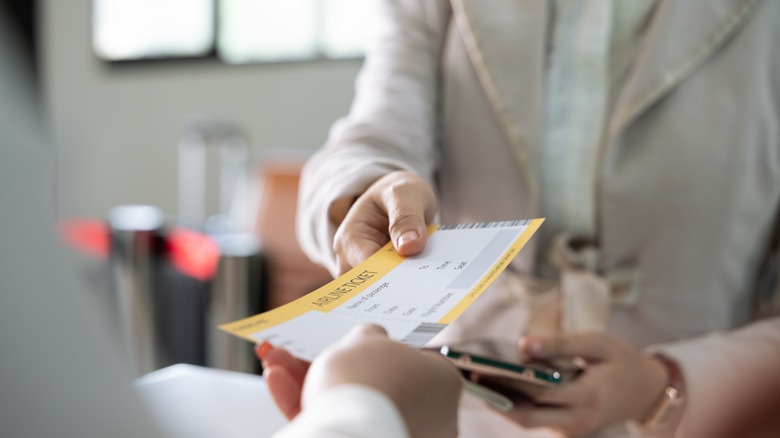Here's What To Do If You Never Get A New Boarding Pass For Your Connecting Flight
Many travelers do their best to book a direct flight to their destination, though sometimes that's just impossible. Whether it's cheaper to have a stopover on your itinerary, someone else booked the flight for you without noting your preferences, or there was simply no choice in the matter, it can add stress to your trip. One of the things that can be an issue when you have a connecting flight is getting the boarding pass for the second leg of your trip. While you usually get this boarding pass when you check in, there are times when you don't, for instance, in the case of some international flights. In this situation, you need to see a gate agent or visit the help desk or customer service.
Of course, that is going to take time, so it's important to know everything about your boarding pass going in, as well as things like where to find customer service, the layout of the airports you're going to be in, and to have all your information readily available. The good news is, we've got all info you need about your boarding pass, what to have handy in case you don't get a pass for your connecting flight, and more useful tips and tricks.
About your boarding pass, and information to have on hand
Boarding passes are full of codes: Sequence numbers can be important as they tell where you fall in the check-in order (which can matter if a flight is overbooked). The SSSS code means a secondary security screening, FTQV is your frequent flier number, and PNR stands for passenger name record. In the case of connecting flights, you may see S/O, which is a stopover, or SPTC, which means you have a stopover that is more than two hours. (All this info is a good reason to stop throwing away your old boarding passes.)
Most people either check in at home (especially for airlines that give you a boarding order based on your check-in time, like Southwest) and get a mobile pass for their phones or print it out at home, or they check in at a kiosk or desk at the airport. In the case of a connecting flight, have all your info at your fingertips so that if you do have to get your second boarding pass during a stopover, you don't have to look for anything. We suggest checking in online, getting the mobile pass, and getting a printed copy, whether at home or at the airport. Even having your frequent flier number handy is a good idea. The less the agent has to look up, the faster things may go. It's worth creating a new photo album in your phone for your trip and storing all the screenshots and info right there.
More tips to make your connecting flight smoother
There are a few other things you can do to make sure you have everything you need accessible when you require it for your connecting flight. Take a screenshot of your mobile pass in case you have data issues when checking in. Write down your confirmation number and put that in your phone as well. Have all the connecting flight info, your ID or passport, and baggage claim tickets with you. When you leave your first flight and get into the airport, take a pic of your connecting terminal and gate number on the screen as soon as you see it. You can look it up by flight number, which you get when you book the flight.
Before you even leave for the airport, make sure you have the airline's app on your phone and you've signed in. You should also have both the domestic and international customer service numbers for your airline(s). It's worth downloading or screenshotting any airport maps with customer service desk and gate locations, as well as terminal info, into that trip album you created in your phone. Another thing it's worth doing is asking a flight attendant on your first flight where to go once you land, as they may be more familiar with the airport than you are.


